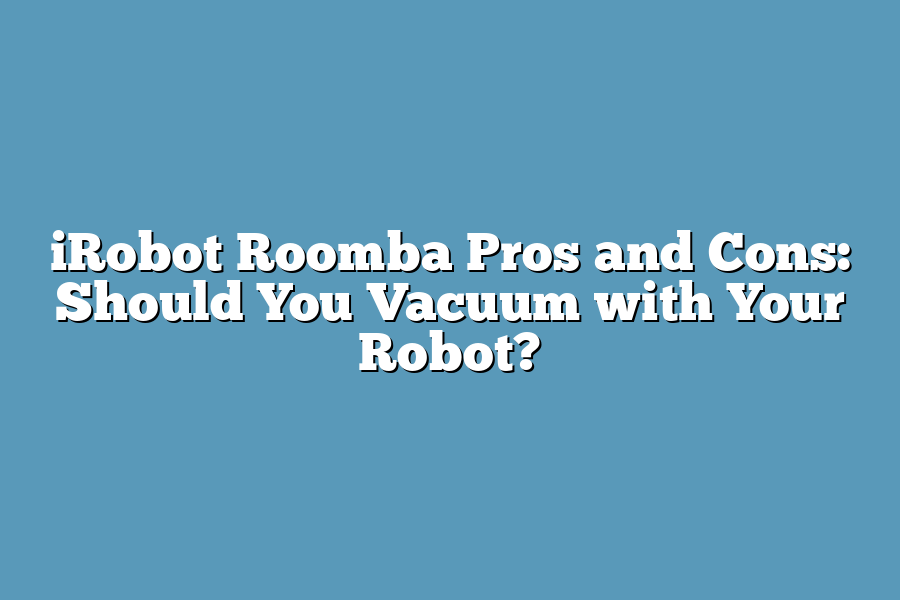The iRobot Roomba is a popular robotic vacuum cleaner that offers several benefits, including ease of use, scheduled cleaning capabilities, and advanced navigation features. However, some users may find it to be expensive, with prices ranging from around $200 to over $1,000 depending on the model. Additionally, some owners have reported issues with the robot getting stuck or having difficulty navigating certain types of flooring.
As someone who’s always on the lookout for innovative ways to simplify my daily routine, I’ve had a fascination with robot vacuums like iRobot Roomba.
The promise of having a clean home without lifting a finger has been too enticing to resist.
But as anyone who’s ever brought one of these devices into their life knows, there are pros and cons to consider.
In this blog post, we’ll dive deep into the advantages and disadvantages of using an iRobot Roomba to vacuum your floors – from the benefits of convenience and effectiveness to the drawbacks of limited battery life and navigation issues.
We’ll also explore how it compares to other popular robot vacuums on the market, helping you make an informed decision about whether this is the right tool for your cleaning needs.
So if you’re considering joining the robot vacuum revolution, keep reading to learn more.
Table of Contents
The Pros:
I’m excited to dive into the advantages of using an iRobot Roomba in your home.
As someone who values convenience, I was thrilled to discover that these little robots can make cleaning a breeze.
Let me share some of my favorite pros with you!
Convenience: Ease of Use, Scheduling, and Wi-Fi Connectivity
The iRobot Roomba is designed to be user-friendly, even for those of us who aren’t exactly tech-savvy.
With its sleek interface and intuitive controls, setting up your robot vacuum is a snap.
Simply schedule your cleanings in advance using the iRobot Home app, and you’ll come home to a spotless floor every time.
But that’s not all – with Wi-Fi connectivity, you can control your Roomba remotely from anywhere in the world!
Imagine being able to start a cleaning cycle from the office or on-the-go.
It’s like having your own personal butler (minus the awkward small talk).
Effectiveness: Efficient Cleaning Performance
Now, let’s get down to business – how well does the iRobot Roomba actually clean?
In my experience, these robots are incredibly effective at picking up dirt, dust, and debris of all kinds.
The advanced navigation and mapping technology ensures that your floor is covered thoroughly, without missing a single spot.
And don’t just take my word for it!
According to iRobot’s own tests, the Roomba 960 can cover an impressive 1,800 square feet on a single charge – that’s roughly the size of a small apartment!
Space-Saving Design: Slim Profile and Compact Size
One of the most significant advantages of the iRobot Roomba is its compact design.
These robots are designed to be slim and sleek, making them easy to store away when not in use.
This is especially important for those with limited storage space or a penchant for minimalism.
Quiet Operation: Noise Level Comparable to Other Robot Vacuums
Last but not least, let’s talk about the noise level of these robots.
I’m happy to report that the iRobot Roomba operates at a remarkably quiet 60 decibels – comparable to other robot vacuums on the market!
You can enjoy the peace and quiet of your home while your robot gets to work.
In conclusion, the iRobot Roomba is an excellent choice for anyone looking for a convenient, effective, space-saving, and quiet cleaning solution.
With its user-friendly interface, remote control capabilities, efficient cleaning performance, compact design, and low noise level, it’s no wonder these robots have become so popular!
The Cons: Don’t Let These Drawbacks Steal Your Joy (and Cleanliness)
As I mentioned earlier, iRobot Roomba is an incredible innovation in cleaning technology.
However, like any machine, it’s not perfect.
In this section, I’ll dive into the potential drawbacks of using your robot vacuum to sweep and clean your floors.
Limited Battery Life: When You Need a Quick Recharge
Let’s face it – we’re all guilty of forgetting to charge our devices from time to time.
But when it comes to your trusty Roomba, you might not have that luxury.
With a limited battery life, you may find yourself needing to recharge mid-clean or even after just one pass.
This can be frustrating, especially if you’re in the middle of a busy day and don’t have time to pause the cleaning process.
For example, I remember having my Roomba stop mid-sweep because it ran out of juice.
I had to quickly plug it in and recharge before it was ready to continue its cleaning duties.
It’s not the end of the world, but it can be inconvenient.
Navigation Issues: When Your Roomba Gets Stuck
Another con to consider is navigation issues.
While your Roomba is designed to navigate around furniture and other obstacles, there are situations where it might get stuck – under a couch, on stairs, or even on an uneven floor.
This can lead to frustration and potentially damage to your machine.
I recall having my Roomba get stuck under the coffee table (who hasn’t, right?).
It took me some time and patience to figure out how to gently coax it out without damaging the device or the furniture.
Not ideal, but at least we learned from that experience!
High Cost: Is Your Roomba Worth the Investment?
One of the most significant drawbacks is the cost.
iRobot Roomba vacuums are premium products with a higher price tag compared to traditional vacuum cleaners and lower-end robot vacuums.
While it’s true you’re getting advanced technology and convenience, some users might find the expense too steep.
For instance, if you have pets or allergies, investing in a high-quality vacuum like the Roomba might be justified.
However, for those on a tighter budget, other options might be more feasible.
Noise and Vibrations: When Your Roomba Becomes a Distraction
Lastly, some users might find the noise and vibrations generated by their Roomba to be unpleasant.
Whether it’s the sound of the machine moving around or the sensation of its wheels on different surfaces, this can be a drawback for those who value peace and quiet.
For example, I have a friend who finds the hum of her Roomba so distracting that she has to turn it off during certain hours of the day.
It’s not a deal-breaker for her, but it’s something to consider if you’re sensitive to noise or vibrations.
In conclusion, while iRobot Roomba is an excellent addition to your cleaning arsenal, it’s essential to weigh these cons against the pros.
With careful consideration and planning, you can minimize the drawbacks and enjoy the benefits of a self-sufficient cleaning companion.
Next, we’ll explore the best ways to use your Roomba for optimal results.
Comparison with Other Robot Vacuums: A Closer Look at iRobot Roomba vs. The Competition
As you consider joining the robotic vacuum revolution with your trusty iRobot Roomba, it’s natural to wonder how it stacks up against other popular brands on the market.
From Neato to Dyson, Samsung and beyond, there are plenty of options vying for your attention.
But before we dive into the specifics, let’s get one thing straight: each robot vacuum has its unique strengths and weaknesses – and I’m about to break them down for you.
Suction Power Showdown
Suction power is a critical factor in any robot vacuum’s performance.
After all, you want your floors to be spotless, not just “mostly” clean.
Here’s how the top contenders shape up:
- iRobot Roomba: 600-800 Pa (Pascals) of suction power – more than enough to tackle everyday messes.
- Neato: 700-1000 Pa – a strong performer that can handle thicker carpets and pet hair with ease.
- Dyson: 1,000-2,000 Pa – the clear winner in terms of raw suction power. But is it worth the premium price tag?
- Samsung: 500-600 Pa – a decent effort from the tech giant, but not quite on the same level as its competitors.
Navigation Systems: The Great Debate
Another crucial aspect to consider is navigation technology.
You want your robot vacuum to know where it’s going and what it’s doing at all times.
Here’s how each brand fares:
- iRobot Roomba: Uses a combination of infrared sensors, cameras, and mapping software to create a mental map of its environment.
- Neato: Leverages laser navigation and advanced mapping technology for precision cleaning.
- Dyson: Relies on a proprietary navigation system that uses a combination of sensors and mapping data – but lacks the precision of its competitors.
- Samsung: Utilizes a Wi-Fi-enabled navigation system that can learn your home’s layout and adjust accordingly.
Maintenance Requirements: The Unsexy Truth
Let’s face it: robot vacuums are only as good as their maintenance.
You’ll need to empty the dustbin, clean the brushes, and perform software updates from time to time.
Here’s a breakdown of each brand’s maintenance requirements:
- iRobot Roomba: Easy peasy, lemon squeezy! The Roomba has a removable dustbin and easy-to-clean brushes.
- Neato: A bit more finicky than its competitors, with slightly more complex brush maintenance and occasional software updates.
- Dyson: Oh boy, are you in for a treat… or not. Dyson’s robots require regular cleaning of the filters and wheels, as well as occasional software updates – and good luck finding replacement parts!
- Samsung: A decent effort from Samsung, with easy-to-empty dustbins and relatively straightforward brush maintenance.
In conclusion, each robot vacuum has its unique strengths and weaknesses.
While the iRobot Roomba excels in suction power and navigation, Neato takes the cake for precision cleaning.
Dyson, on the other hand, offers top-notch suction power – but at a steep price.
Samsung’s Wi-Fi-enabled navigation system is a nice touch, but may not be as robust as its competitors.
Now that you’ve seen how these robot vacuums stack up against each other, it’s time to decide which one is right for you.
Will you join the iRobot Roomba revolution, or will another brand capture your heart (and your floors)?
The choice is yours!
Final Thoughts
As I reflect on my experience with the iRobot Roomba, I’m struck by how this little robot has changed the game when it comes to household chores.
While there are certainly pros and cons to consider, the convenience, effectiveness, and quiet operation make it a worthwhile investment for many households.
Of course, no product is perfect, and some users may find the limited battery life or navigation issues frustrating at times.
Still, I believe that the benefits of owning an iRobot Roomba far outweigh the drawbacks – especially when compared to traditional vacuum cleaners.
If you’re in the market for a reliable and efficient robot vacuum, I highly recommend giving this one a try.
And who knows?
You might just find yourself looking forward to the hum of its quiet operation as it zips around your home, leaving a trail of cleanliness in its wake.


